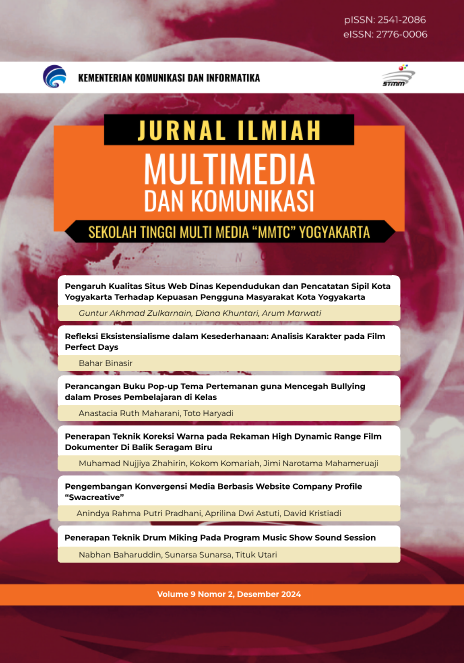Existentialism Reflections in Simplicity: A Character Analysis in the Film Perfect Days
DOI:
https://doi.org/10.56873/jimk.v9i2.348Keywords:
Existentialism, character analysis, cinematography, freedom, alienationAbstract
This research focuses on analyzing the character of Hirayama in the film Perfect Days (2023) by Wim Wenders through the lens of existentialist philosophy. Utilizing a qualitative method, particularly narrative and character analysis, this research explores how Hirayama’s simple routines and minimalist actions reflect existential themes, such as alienation, individual freedom, and the search for meaning in life. The film employs a minimalist visual style, using techniques such as framing and deep-focus photography to emphasize Hirayama’s emotional isolation and reflective journey. The study reveals that Perfect Days offers a philosophical reflection on how simple daily routines can serve as a medium for existential introspection, in line with the existentialist ideas proposed by Jean-Paul Sartre and Martin Heidegger. This research provides academic value by expanding discussions on existentialism in contemporary cinema and offers practical insights for filmmakers in exploring philosophical themes through a simple yet profound cinematic approach, as well as for audiences in understanding philosophical messages conveyed through narrative and visual elements.Downloads
References
Barthes, R. (1977). Image, music, text (S. Heath, Trans.). Fontana.
Bazin, A. (2005). What is cinema? vol. I. University of California Press.
Bordwell, D., Thompson, K., & Smith, J. (2020). Film art: An introduction. McGraw-Hill Education.
BouleÌ, J.-P., McCaffrey, E., Cooper, S., Darnell, M. R., Falzon, C., Martin, T., Williams, P., Nicholls, T., Rolls, A., Stoehr, K. L., & Stanton, M. (2011). Existentialism and contemporary cinema: A sartrean perspective. Berghahn Books.
Capp, R. (2024). Perfect days. The Gerontologist, 64(10). https://doi.org/10.1093/geront/gnae098
Chatman, S. (1978). Story and discourse: Narrative structure in fiction and film. Cornell University Press.
Desiderio, M. J., Gaycken, O., Singer, A., Alter, N. M., & Corrigan, T. (2011). Wandering: Seeing the cinema of Wim Wenders through cultural theory and naturalized phenomenology (Publication No. 3440069) [Doctoral dissertation, Temple University]. UMI Dissertation & ProQuest
Goodenough, J., & Read, R. J. (2007). Film as philosophy: Essays in Cinema after Wittgenstein and Cavell. Palgrave Macmillan.
Graf, A. (2004). The Cinema of Wim Wenders: The celluloid highway. Wallflower.
Hajduk, J. (2024). High bias: The distorted history of the cassette tape by Marc Masters (review). Technology and Culture, 65(4), 1393–1394. https://doi.org/10.1353/tech.2024.a940492
Handa, R. (2024). Perfect days. Journal of the Society of Architectural Historians, 83(4), 565–568. https://doi.org/10.1525/jsah.2024.83.4.565
Heidegger, M. (1996). Being and time: A translation of sein und zeit (J. Stambaugh, Trans.). State University of New York Press.
Merleau-Ponty, M. (2005). Phenomenology of perception. Routledge.
Reynolds, J. (2006). Understanding existentialism. Acumen.
Sartre, J.-P. (2007). Existentialism is a humanism: (l’existentialisme est un humanisme) (C. Macomber, Trans., J. Kulka, Ed.). Yale University Press.
Sartre, J.-P. (2021). Being and nothingness: An essay in phenomenological ontology (S. Richmond, Trans.). Atria Books.
Smith, M. (2004). Engaging characters: Fiction, emotion, and the cinema. Clarendon Press ; Oxford University Press.
Sobchack, V. C. (1992). The address of the eye: A phenomenology of film experience. Princeton University Press.
Downloads
Published
Issue
Section
License
Penulis yang menerbitkan artikel di jurnal ini menyetujui ketentuan berikut:
1. Hak Cipta tetap pada penulis dan memberikan hak kepada Jurnal Ilmiah Komunikasi dan Multimedia sebagai otoritas untuk menerbitkan artikel dengan Lisensi Creative Commons Atribusi 4.0 Internasional, yang memungkinkan artikel untuk dibagikan dengan sepengetahuan penulis artikel dan jurnal ini sebagai tempat publikasi.
2. Penulis dapat mendistribusikan publikasi artikelnya secara non-eksklusif (misalnya: pada repositori universitas atau buku) dengan pemberitahuan atau pengakuan publikasi di jurnal Option.
3. Penulis diperbolehkan memposting karyanya secara online (misalnya: di situs pribadi atau di repositori universitas) sebelum dan sesudah proses penyerahan (lihat Pengaruh Akses Terbuka)









